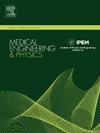Fatigue test evaluation of a customised humeral component for an instrumented total elbow prosthesis and strain validation study
IF 1.7
4区 医学
Q3 ENGINEERING, BIOMEDICAL
引用次数: 0
Abstract
The survival rate of total elbow arthroplasty (TEA) is negatively impacted by the lack of available data on elbow biomechanics. This study developed a modified humeral component for TEA that is purposed to be instrumented to generate real-time 6 degrees of freedom (d.o.f) force and moment data during activities of daily living (ADL). The objectives are twofold: (1) to assess the safety of the modified humeral component under peak anticipated loads in fatigue, and (2) verify the strains measured under physiological loads with strains modelled using finite element analysis (FEA). Four modified titanium alloy humeral components were welded, and fatigue tested at 5 Hz for 5 million cycles under a compressive load of 700 N corresponding to moderate ADL. The strains were measured using triaxial 350 Ω rectangular rosette (45°) strain gauges bonded to three specific locations on the humeral component confirmed through an FE study. The four welded humeral components successfully withstood fatigue conditions and did not deform. The measured and modelled principal strains were confirmed to be highest at the external wall of the lateral cavity, with a percentage difference of <10 %.
全肘关节假体定制肱骨构件疲劳试验评估及应变验证研究
由于肘关节生物力学数据的缺乏,影响了全肘关节置换术(TEA)的生存率。本研究开发了一种用于TEA的改良肱骨组件,用于在日常生活活动(ADL)期间产生实时6自由度(d.o.f)力和力矩数据。目标有两个:(1)评估改进的肱骨构件在疲劳峰值预期载荷下的安全性;(2)用有限元分析(FEA)模拟的应变验证生理载荷下测量的应变。焊接4个改良钛合金肱骨构件,在中等ADL对应的700 N压缩载荷下,在5 Hz下进行500万次疲劳试验。应变测量使用三轴350 Ω矩形玫瑰(45°)应变片,通过有限元研究确定连接到肱骨部件的三个特定位置。四个焊接的肱骨部件成功地经受了疲劳条件,没有变形。实测的主应变和模拟的主应变在侧腔的外侧壁处最大,两者的百分比差异为10%。
本文章由计算机程序翻译,如有差异,请以英文原文为准。
求助全文
约1分钟内获得全文
求助全文
来源期刊

Medical Engineering & Physics
工程技术-工程:生物医学
CiteScore
4.30
自引率
4.50%
发文量
172
审稿时长
3.0 months
期刊介绍:
Medical Engineering & Physics provides a forum for the publication of the latest developments in biomedical engineering, and reflects the essential multidisciplinary nature of the subject. The journal publishes in-depth critical reviews, scientific papers and technical notes. Our focus encompasses the application of the basic principles of physics and engineering to the development of medical devices and technology, with the ultimate aim of producing improvements in the quality of health care.Topics covered include biomechanics, biomaterials, mechanobiology, rehabilitation engineering, biomedical signal processing and medical device development. Medical Engineering & Physics aims to keep both engineers and clinicians abreast of the latest applications of technology to health care.
 求助内容:
求助内容: 应助结果提醒方式:
应助结果提醒方式:


